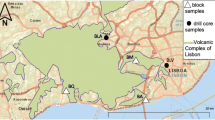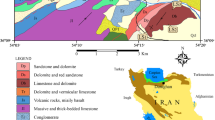Abstract
Engineering properties of rocks vary as they are heterogeneous materials by nature because of mineralogical composition, texture, porosity, and alteration, etc. This study focuses on the investigation of the relationship between internal structure and engineering parameters of basalt samples by digitizing the textural properties. Thin sections studies of basalts were made into three groups: aphanitic, amygdaloidal, and vesicular on the basis of texture. Further, the textural properties were digitized in thin sections and the texture coefficient (TC) of each group was calculated. Uniaxial compressive strength, dry unit weight, point load strength index, Schmidt hammer rebound, and P-wave velocity of the samples were determined in the laboratory. Simple regression analyses were performed using the laboratory results incorporating first TC and engineering parameters and the second phase of the analysis focused on the relationship between uniaxial compressive strength and the rest of the parameters of samples with different texture coefficients. The highest texture coefficient was found to be 0.50 in aphanitic basalts while vesicular basalts have the lowest TC of 0.37. As the TC increases, rock strength increases. Strong-very strong correlations between uniaxial compressive strength and the rest of the engineering parameters of aphanitic and amygdaloidal-basalts with a TC of 0.50 and 0.45 are in agreement with the findings in the literature while there are no meaningful correlations between uniaxial strength and the aforementioned parameters except dry unit weight in vesicular basalts. These results indicate that the presence of empty pores in vesicular basalts reduced the uniaxial compressive strength and TC by increasing the heterogeneity.
Similar content being viewed by others
References
Akbay, S. (2016) Geology and petrology of Musabeyli-Sorgun (YOZGAT) volcanic rocks. Master’s thesis, Ankara University, Turkey, 145 p (in Turkish).
Akce, M.A. and Kadioglu, Y.K. (2005) Petrology of leucogranites from the northern part of Yozgat batholith. Geol. Bull. Turkey., Vol. 48/2, pp.1–20 (in Turkish).
Al-Harthi, A.A., Al-Amri, R.M. and Shehata, W.M. (1999) The porosity and engineering properties of vesicular basalt in Saudi Arabia. Engg. Geol., v.54 (3-4), pp.313–320.
Alpaslan, M. and Temel, A. (2000) Petrographic and Geochemical Evidence for Magma Mixing and Crustal Contamination in the Post-Collisional Calc-AlkalineYozgatVolcanics, Central Anatolia, Turkey, Int. Geol. Rev. v.42/9, pp.850–863.
American Society for Testing and Materials (2001) Standard practices for preparing rock core specimens and determining dimensional and shape tolerances. ASTM, D4543.
Barbour, T.G., Atkinson, R.H. and Ko, H.Y. (1979) Relationship of mechanical, index and mineralogical properties of coal measure rock. 20th Symp. Rock Mech., Austin, pp.189–198.
Basu, A. and Kamran, M. (2010) Point load test on schistose rocks and its applicability in predicting uniaxial compressive strength. Int. Jour. Rock Mech. Min. Sci., v.47, pp.823–828.
Bell, FG. (1978) The physical and mechanical properties of the Fell sandstones, Northumberland, England. Engg. Geol., v.12, pp.1–29.
Brace, W.F. (1961) Dependence of fracture strength of rocks on grain size. 4th Symp. Rock Mech, Univ. Park, Penn., pp.99–103.
Cashman, K.V. and Kauahikaua, J.P. (1997) Reevaluation of vesicle distributions in basaltic lava flows. Geology, v.25, pp.419–422.
Cevýk, A., Akcapinar Sezer, E., Cabalar, A. F. and Gokceoglu, C. (2011) Modeling of the uniaxial compressive strength of some clay-bearing rocks using neural network.Appl. Soft Comput., v.11, pp.2587–2594.
Deere, D.U. and Miller, R.P. (1966) Engineering classification and index properties for intact rocks. Tech Rep Air Force Weapons Lab, New Mexico, no AFNL-TR, pp.65–116.
Diamantis, K., Gartzos, E. and Migiros, G. (2009) Study on uniaxial compressive strength, point load strength index, dynamic and physical properties of serpentinites from Central Greece. Test results and empirical relations: Eng. Geol., v.108, pp.199–207.
Diamantis, K., Bellas, S., Migiros, G. and Gartzos, E. (2011) Correlating wave velocities with physical, mechanical properties and petrographic characteristics of peridotites from the central Greece. Geotech. Geol. Engg., v.29, pp.1049–1062.
Dincer, I., Acar, A., Cobanoglu, I. and Uras, Y. (2004) Correlation between Schmidt hardness, uniaxial compressive strength and Young’s modulus for andesites, basalts and tuffs. Bull. Eng. Geol. Env., v.63, pp.141–148.
Duraiswami, R.A., Gadpallu, P., Tahira, Shaikh, T.N. and Cardin, N. (2014) Pahoehoe-a’a transitions in the lava flow fields of the western Deccan Traps, India-implications for emplacement dynamics, flood basalt architecture and volcanic stratigraphy. Jour. Asian Earth Sci. v.84, pp.146–166.
Entwisle, D.C., Hobbs, P.R.N., Jones, L.D., Gunn, D. and Raines, M.G. (2005) The relationship between effective porosity, uniaxial compressivestrength and sonic velocity of intact Borrowdale volcanic group core samples from Sella field. Geotech. Geol. Engg., v.23, pp.793–809
Erdogan, B., Akay, E. and Ugur, S. (1996) Geology of the Yozgat region and evolution of the collisional Çankiri basin. Int. Geol. Rev., v.38, pp.788–806.
Ersoy, A. and Waller, M.D. (1995) Textural characterization of rocks.Eng. Geol., v.39, pp.123–136.
Fener, M., Kahraman, S., Bilgil, A. and Gunaydin, O (2005) A Comparative Evaluation of Indirect Methods to Estimate the Compressive Strength of Rocks. Rock Mech. Rock Engg., v.38(4), pp.329–343.
Fourmaintraux, D. (1976) Characterization of rocks laboratory tests. In: Panet, M. (Ed.), La Mechanique des roches applique aux ouvrges du genie civil. Ecole Nationale des Pontset Chaussees, Paris, (chapter IV).
Gokceoglu, C. (2002) A fuzzy triangular chart to predict the uniaxial compressive strength of the Ankara agglomerates from their petrographic composition. Engg. Geol., v.66(1–2), pp.39–51.
Gokceoglu, C. and Zorlu, K. (2004) A fuzzy model to predict the uniaxial compressive strength and the modulus of elasticity of a problematic rock. Engg. Geol., v.17, pp.61–72.
Goodman, R. E. (1993) Engineering Geology. Rock in Engineering Construction: Wiley, NY, 432 p.
Goodman, R.E. (1998) Introduction to Rock Mechanics. 2nd ed. John Wiley and Sons, NY.
Goncuoglu, M.C., Toprak, V., Erler, A. and Kuscu, I. (1991) Orta Anadolu Bati Kesiminin Jeolojisi, Bölüm 1, Güney Kesim.TPAO rap. No 2909, 176 pp (In Turkish, unpublished)
Gupta, V. and Sharma, R. (2012) Relationship between textural, petrophysical and mechanical properties of quartzites: a case study from northwestern Himalaya. Engg. Geol., v.135–136, pp.1–9.
Handing, J. and Hager, R.V. (1957) Experimental deformation of sedimentary rock under a confining pressure.A.A.P.G., v.41, pp.1–50.
Hawkýns, A.B. (1998) Aspects of rock strength. Bull. Engg. Geol. Environ., v.57, pp.17–30.
Howarth, D.F. and Rowlands, J.C. (1986) Development of an index to quantify rock texture for qualitative assessment to intact rock specimens. Geotech. Test. Jour., v.9(4), pp.169–179.
Irfan, T.Y. (1996) Mineralogy, fabric properties, and classification of weathered granites in Hong Kong.Q. Jour. Eng. Geol. Hydrogeol., v.29, pp.5–35.
International Society for Rock Mechanics (2007) The complete ISRM suggested methods for rock characterization, testing and monitoring.1974–2006. In: Ulusay, Hudson (Eds.), Suggested methods prepared by the commission on testing methods, ISRM. ISRM Turkish National Group, Ankara, Turkey, 628 pp.
Jeng, F.S., Weng, M.C., Lin, M.L. and Huang, T.H. (2004) Influence of petrographic parameters on geotechnical properties of Tertiary sandstones from Taiwan: Eng. Geol., v.73, pp.71–91.
Kahraman, S. (2001) Evaluation of simple methods for assessing the uniaxial compressive strength of rock. Int. Jour. Rock Mech. Min. Sci., v.38, pp.981–994.
Kahraman, S., Gunaydin, O. and Fener, M. (2005) The effect of porosity on the relation between uniaxial compressive strength and point load index. Int. Jour. Rock Mech. Min. Sci., v.42(4), pp.584–589.
Kahraman, S. and Gunaydýn, O. (2009) The effect of rock classes on the relation between uniaxial compressive strength and point load index. Bull. Eng. Geol. Environ., v.68, pp.345–353.
Karakul, H., Ulusay, R. and Isik, N. S. (2010) Empirical models and numerical analysis for assessing strength anisotropy based on block punch index and uniaxial compression tests. Int. Jour. Rock Mech. Min. Sci., v.47, pp.657–665.
Kayabali, K. and Selcuk, L. (2010) Nail penetration test for determining the uniaxial compressive strength of rock. Int. Jour. Rock Mech. Min. Sci., v.47, pp.265–271.
Ketýn, I. (1955) Yozgat bölgesinin jeolojisive Orta Anadolumasi finintektonik durumu. Bull. Geol. Soc. Turkey, v.6, pp.1–40 (in Turkish).
Kilic¸ A. and Teymen, A. (2008) Determination of mechanical properties of rocks using simple methods. Bull. Engg. Geol. Environ. v.67, pp.237–244.
Korkanc, M. and Tugrul, A. (2004) Evaluation of selected basalts from Nigde, Turkey, as source of concrete aggregate. Engg. Geol., v.75, pp.291–307.
Mendes, F.M., Aires-Barros, L. and Rodrigues, F.P. (1966) The use of modal analysis in the mechanical characterization of rock masses.1st Internat. Congress Rock Mechanics., Lisbon, v.1, pp.217–223.
Merrýam, R., Rieke, H H. and Kim, Y.C. (1970) Tensile strength related to mineralogy and texture of some granitic rocks. Engg. Geol., v.4, pp.155–160.
Onodera, T.F. and Ashoka, K.H.M. (1980) Relation between texture and mechanical properties of crystalline rocks. Bull. Int. Assoc. Engg. Geol., v.22, pp.173–177.
Ozturk, C. A. and Nasuf, E. (2013) Strength classification of rock material based on textural properties. Tunn.Undergr. Sp. Tech., v.37, pp.45–54.
Pomonis, P., Rigopoulos, I., Tsikouras, B. and Hatzipanagiotou, K. (2007) Relationships between petrographic and physico-mechanical properties of basic igneous rocks from the Pindos ophiolitic complex, NW Greece. Bull. Geol. Soc. Greece., v.4(2), pp.947–958.
Prikrly, R. (2006) Assessment of rock geomechanical quality by quantitative rock fabric coefficients: Limitations and possible source of misinterpretations. Engg. Geol., v.87, pp.149–162.
Rýgopoulos, I., Tsikouras, B., Pomonis, P. and Hatzipanagýotou, K. (2010) The influence of alteration on the engineering properties of dolerites: The examples from the Pindos and Vourinos ophiolites (northern Greece). Int. Jour. Rock Mech. Min. Sci., v.47, pp.69–80.
Ruffolo, R. M. and Shakoor, A. (2009) Variability of unconfined compressive strength in relation to number of test samples. Engg. Geol., v.108, pp.16–23.
Sengor, A.M.C. and Yilmaz, Y. (1981) Tethyan evolution of Turkey, A plate tectonic approach. Tectonophysics., v.75, pp.181–241.
Shakoor, A. and Bonelli, R.E. (1991) Relationship between petrographic characteristics, engineering index properties, and mechanical properties of selected sandstones. Bull. Assoc. Eng. Geologists, v.28, pp.55–71.
Sharma, P.K. and Singh, T.N. (2008) A Correlation between P-Wave Velocity, Impact Strength Index, Slake Durability Index and Uniaxial Compressive Strength. Bull. Engg. Geol. Environ., v.67, pp.17–22.
Sonmez, H., Tuncay, E. and Gokceoglu, C. (2004) Models to predict the uniaxial compressive strength and the modulus of elasticity for Ankara Agglomerate. Internat. Jour. Rock Mech. Min. Sci., v.41(5), pp.717–729.
Sonmez, H., Gokceoglu, C., Medley, E.W., Tuncay, E.and Nefeslioglu, H.A. (2006) Estimating the uniaxial compressive strength of a volcanic bimrock. Int. Jour. Rock Mech. Min. Sci., v.43, pp.554–561.
Statistical Package for Social Sciences (1998) SPSS, SPSS Inc., USA, 562p.
Tsýambaos, G. and Sabatakakis, N. (2004) Considerations on strength of intact sedimentary rocks. Engg. Geol., v.72, pp.261–273.
Tandon, R.S. and Gupta, V. (2013) The control of mineral constituents and textural characteristics on the petrophysical and mechanical (PM) properties of different rocks of the Himalaya. Engg. Geol., v.153, pp.125–143.
Tugrul, A. and Zarif, I.H. (1999) Correlation of Mineralogical and Textural Characteristics with Engineering Properties of Selected Granitic Rocks from Turkey. Engg. Geol., v.51, pp.303–317.
Ulusay, R., Tureli, K. and Ider, M.H. (1994) Prediction of engineering properties of a selected litharenite sandstone from its petrographic characteristics using correlation and multivariate statistical techniques. Engg. Geol., v.7, pp.135–157.
Williams, H. (1982) Petrography. W. H. Freeman & Company, San Francisco, p. 369.
Yagiz, S. (2008) Predicting uniaxial compressive strength, modulus of elasticity and index properties of rocks using the Schmidt hammer. Bull. Engg. Geol. Environ., v.68, pp.55–63.
Yilmaz, I. and Sendir, H. (2002) Correlation of Schmidt hammer rebound number with unconfined compressive strength and Young’s modulus in gypsum from Sivas (Turkey). Engg. Geol., v.66, pp.211–219.
Author information
Authors and Affiliations
Corresponding author
Rights and permissions
About this article
Cite this article
Kolay, E., Baser, T. The effect of the textural characteristics on the engineering properties of the basalts from Yozgat region, Turkey. J Geol Soc India 90, 102–110 (2017). https://doi.org/10.1007/s12594-017-0669-9
Received:
Revised:
Published:
Issue Date:
DOI: https://doi.org/10.1007/s12594-017-0669-9




